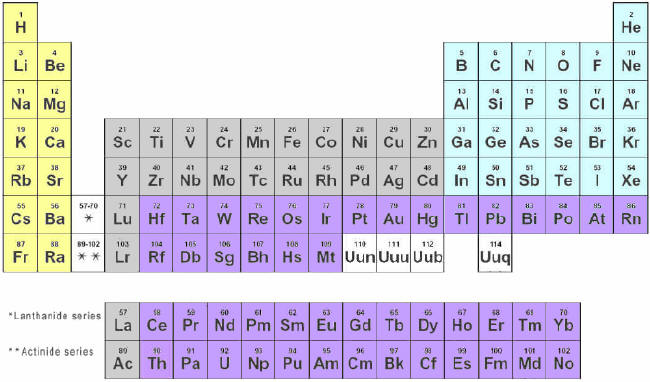|
LESSON 3. Ions, Molecules, and
Compounds
|
Objective:
Understand the similarities and difference of ions, molecules, and
compounds. |
Materials:
Periodic Table Placemat (recommended Painless Learning version)
|
Teacher Notes:
The Periodic Table is
useful in determining which elements may become compounds. This worksheet
has them look at the Periodic Table again, but tries to get them to see
how the elements “hook up” in the real world.
This material builds
up for Lesson 4, where the students will construct their own molecules.
This will help them understand this chapter’s written material.
Note that this lesson
does not require any modification if you do use the recommended Periodic
Table. |
ANSWERS:
-
|
MINERAL |
Chemical formula |
Cation |
Anion |
|
Hematite
|
Fe2O3 |
Fe |
O |
|
halite
|
NaCl |
Na |
Cl |
|
quartz
|
SiO2 |
Si |
O |
|
pyrite
|
FeS2 |
Fe |
S |
|
galena
|
PbS |
Pb |
S |
|
fluorite
|
CaF2 |
Ca |
F |
-
They are noble gases
and do not have the need to donate or borrow electrons.
-
|
|
Monatomic or Polyatomic? |
|
Fe+3 |
monatomic |
|
Fe+2 |
monatomic |
|
NO3-1 |
polyatomic |
|
SO4-2 |
polyatomic |
|
Na+1 |
monatomic |
|
PO4-3 |
polyatomic |
|
Al+3 |
monatomic |
|
CO3-2 |
polyatomic |
|
H+1 |
monatomic |
|
Sn+4 |
monatomic |
|
OH-1 |
polyatomic |
-

-
Ca (Calcium); O
(Oxygen) yes; Re(Rhenium) Ir(Iridium) no; Ce (Cerium), Ru(Ruthenium)
no; Ca (Calcium), F(Fluorine) yes; Mg (Magnesium), O (oxygen), yes; Ba
(Barium), La (Lanthanum) no; Na (Sodium), Mg (Magnesium), no; Na (Sodium), I
(Iodine), yes; W (Tungsten), Xe (Xeon), no; Au (Gold), Ag (Silver), no
|